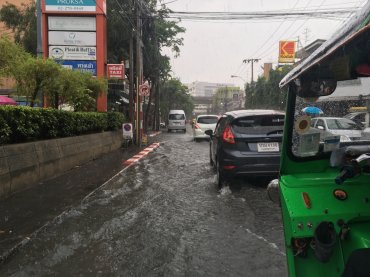As in the United States, large storms and heavy rains have caused flooding and other disruptions throughout much of Asia-Pacific. So far, however, it appears the regions lubricant markets have largely avoided being impacted except by the diversion of local base oil supplies to the U.S.
Since late June, floods due to heavy rains affected more than 30 million people, bringing transportation and ports in countries like China, India and Thailand coming to temporary standstills. In the U.S., Hurricane Harvey disrupted operations at several base oil plants along the Gulf of Mexico Coast.

Photo: itman__47/Shutterstock.com
Heavy recent rains caused flooding in Thailand and other countries but reportedly had little impact on base oil and lubricant markets.
Blending plants in China were not affected by the floods, but some players said there was some impact on imports of base oils for low-viscosity lubricants due to diversion of supply from Asian sources, a lubricant blender in China, who spoke on condition of anonymity, said during an interview last week. Also, with new blending capacities coming on stream in two years time, we are not sure how supply and demand will pan out. It is a wait-and-see situation.
We are coordinating with our U.S. colleagues to monitor the situation in their market in order to assess any potential impact on Asia-Pacific markets, added a spokesperson from Chevron in Singapore.
Floods affected transportation in Thailand and Vietnam, but Volume wise, PTT has not been affected by this ongoing situation [of base oil supplies from Asia going to the U.S.] because PTT has long-term contracts with base oil producers. However, we are keeping our eyes closely on base oil supply in the market, said a spokesperson from Thailands state-owned lubricant blender, PTT Lubricants.
Since floods occurred in the northern and eastern parts of Thailand, and PTTs main blending facilities and warehouse are in the middle, the floods did not affect our deliveries, she added.
In India, local lubricant blenders were affected by road and port stoppages for a few days with deliveries of finished lubricants coming to a standstill and some employees unable commute to plants. However, supply chain operations resumed quickly and rate of operation of plants were not affected.
Indias oil demand fell 6 percent in August due to severe rains that caused widespread flooding in west and northeast India, leading to sharp reductions in construction and vehicle-miles travelled.Seasonal rainfall that caused floods in Assam, West Bengal, Bihar and Gujarat provinces led to a decline in transportation affecting demand for both gasoline and diesel, said Energy Aspects, a global energy market consultancy.
In August, floods caused by heavy monsoon rains devastated parts of Bangladesh, India and Nepal, affecting 24 million people while heavy rains in southern China caused floods and landslides affecting over 7.3 million people since late June. The Chinese government is providing 1.88 billion (U.S. $276.8 million) for disaster relief in 20 provinces and regions.
In Thailand and northern Vietnam, flash floods affected about 1.8 million people since the monsoon rains started in early August. In Vietnam, typhoon Doksuris arrival in September forced 80,000 people to evacuate from coastal regions.
According to a recent report by the Asian Development Bank and the Potsdam Institute for Climate Impact Research, 13 of the 20 cities projected to have the fastest growth in flood losses from 2005 to 2050 are in Asia and the Pacific: Guangzhou, Shenzhen, Tianjin, Zhanjiang, and Xiamen in China; Mumbai, Chennai-Madras, Surat, and Kolkata in India; Ho Chi Minh City; Jakarta; Bangkok; and Nagoya, Japan.